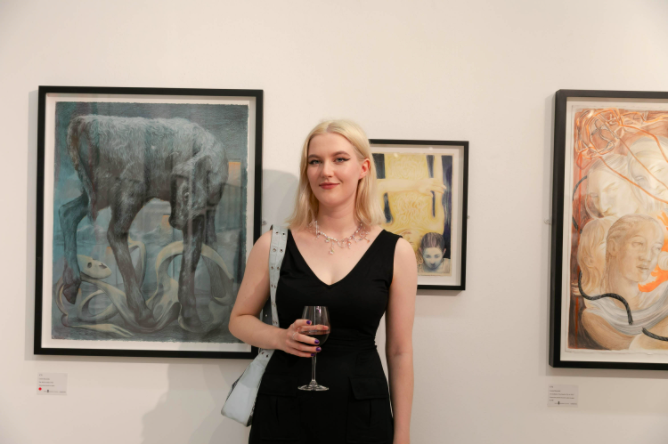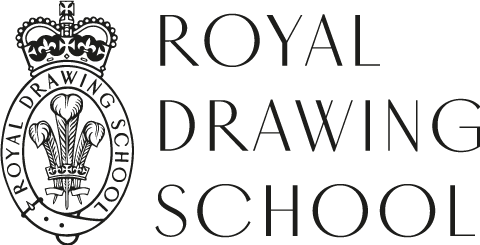Louise Reynolds
Drawing Year 2022
Painting & Printmaking, Glasgow School of Art

What were you doing before The Drawing Year and what drew you to apply?
Before the Drawing Year I studied Painting & Printmaking at Glasgow School of Art, graduating in 2020. My degree show was cancelled due to the pandemic, so I felt I had missed out on a huge opportunity. I knew I wanted to apply to The Drawing Year after a talk we were given at GSA by a alumni from the school, where it sounded like an environment where people were keen to improve. I really wanted to learn in a skills-based environment with in depth tuition, as I felt on reflection that my degree had been largely self led.
Which courses have most impacted your practice?
The courses which have impacted my practice the most are Etching, Satire and Sacred in Art and Enduring Images: Stories of Art. Working in the printroom has been a revelation and I feel I’ve discovered a key element of my practice that I need to continue with. It’s helped me to be decisive and improve my linework, and I love the physical aspect of making drypoints. I did Satire and Sacred in my first term at the Drawing School and I loved that it took me to places across London that I’d never seen before as a newcomer to the city. It really tested my confidence in drawing in busy public places which I’m now very grateful for, and the satirical aspect especially inspired me. Enduring Images is incredibly inspiring in that it addresses themes that recur throughout visual history, and encourages you to think about your own interpretation of these themes through figuration. This method of thinking and art historical context fed a lot into my studio work.

Tell us about your practice and the part that drawing plays...
Habitually reading the news provides a point of departure for my work, by combining prevailing and fad narratives into a vision of a dystopian present and future. My work is largely figurative, and I feel that picking out small phrases or ideas from the current news and distorting them into something unrecognisable and fantastical speaks to how overwhelming we find the oversaturation of the media, and how little of it we can fully understand. I feel that drawing is now essential to my practice, and not just a preparatory stage. I work a lot from my imagination and practising so much observational drawing has increased my ability to invent imagery.
What are the most important things that you've learned during the year?
Aside from improving my technical skills, the most important thing I’ve learned is to push through every drawing to the very end. With so many classes every week, but only so many hours in a day, you really learn to squeeze every drop out of your time. I would always find myself pushing things to completion in a way that I don’t think I had before. I think this is because you are constantly being challenged. I think now I can take this kind of productive drive to the studio after a year of working in such a headspace.

What opportunities have arisen due to The Drawing Year?
I’ve been contacted by some exciting curators, sold to collectors, and had the opportunity to talk to people about my work that I couldn’t have imagined. I’ve never had an opportunity like this in my life and I’m extremely grateful for the platform The Drawing Year has given us all. At this stage I have a couple of group exhibitions and a residency upcoming that wouldn’t have been possible without the School’s support. I’m also teaching on the Young Artist’s programme, which has been a great opportunity as I had no previous teaching experience. Being able to impart some of my enthusiasm to young people has been very fulfilling, as I know the art teachers I had growing up were completely formative in becoming the artist I am now.
Tell us about the sense of community on the course...
The community aspect of the Drawing Year is vital to my appreciation for the course, as I moved to London without knowing anyone, and now I have amazing bonds with artists that I’ll know for my whole life. In such an intensive learning environment you form strong bonds and memories so quickly, and it’s invigorating to be around a cohort of people who are genuinely passionate about making work too.
Which tutors have you most enjoyed working with and why?
I most enjoyed working with Lindsey Sekulowicz, Rossen Daskalov, Mark Cazalet, and Marcus Cornish. Lindsey always brought great historic context to her classes and set up some amazing life room scenarios for us to work from, such as drawing shadows, fabrics and frottage. Rossen’s advice has been really influential for me throughout the year in composition, tone and his encouragement, alongside his technical knowledge in the print room. Mark always made us consider new approaches to our work, with lots of interesting references to consider and gave me a personal breakthrough about my drawing technique. Marcus gave us a lot of valuable technical and contextual knowledge in his classes and I’ve learnt so much from him about both anatomy and visual history.
What has surprised you about The Drawing Year?
I’ve been surprised by all of the experiences we’ve had throughout the year, from painting a mural together, and exciting Core days, to the Italy trip. The year gave me so much enjoyment throughout all the hard work. I was also always surprised by just how varied everyone’s work was at the end of each day, even if we were given a fairly prescriptive task, the breadth of my peers' work was always amazing.

What is it like to study and live in London?
Living and studying in London is invigorating and the pace of life I’ve adopted here has been transformative. After my degree show was cancelled due to the pandemic, and moving home with my shielded family for over a year before starting the course, the shift for me was huge. I lived in Glasgow during my degree, but I wasn’t fully prepared for how enveloping London is as a city to live in. Now I find that feeling really thrilling, and being able to study in a city with the most incredible art collections, museums, galleries, and artists is a wonder.
What are you going on to do after completing the course?
I’m staying in London for the next year to try to continue to prioritise my artistic career by seeing where these new opportunities and contacts I’ve made will take me. I also have a couple of residencies to complete, and will hopefully find a studio space in London once they’re done. In the meantime I’m still making new works, and doing my part time jobs.
What does it mean to you that the course has no fees and a free studio space?
Without the course being free I would never have had the push to move to London, which has proven to be so inspiring. It’s such a crucial resource to make high quality arts education accessible to people who simply wouldn’t consider the fees of a traditional MA in London, and the Drawing School surpassed all my expectations. Having a free studio space alone is a huge privilege, aside from all of the great tutors to learn from and facilities to be used at the School. I feel strongly that the School is made up of a very special community of people, and it wouldn’t be so special if talented people were put off by a price as I’m sure they are at other institutions.
What advice would you give to someone considering applying for the course?
I would advise anyone applying to the course to find the drawing mediums they enjoy using the most and push them as far as they can. I think once you become invested in your mediums the work improves so much overall as a result, and you can really feel when someone loves what they’re using. Of course I’d also encourage them to start drawing every day now, so they’re prepared!
